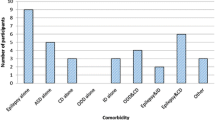Abstract
In this study, standardized assessments of maternal psychopathology, family functioning and marital adjustment were compared between 115 medication naïve, clinically referred primary school age children with Attention Deficit Hyperactivity Disorder combined type (ADHD-CT) alone and 29 children with comorbid dysthymic disorder (DD) and ADHD-CT. The mothers of children with ADHD-CT and DD reported higher rates of anxiety and depression than those of children with ADHD-CT alone. These results reinforce the need for early recognition of comorbid DD when working with children with ADHD-CT. Increased rates of maternal anxiety and depression in children with ADHD-CT and DD may contribute to the children’s symptoms, require specific psychological and/or medication treatments and careful ongoing monitoring of these specific treatments.
Similar content being viewed by others
References
Biederman J, Faraone S, Mick E, Lelon E (1995) Psychiatric comorbidity among referred juveniles with major depression: fact or artefact. J Am Acad Child Adolesc Psychiatry 34:579–590
Milberger S, Biederman J, Fararone S, Murphy J, Tsuang M (1995) Attention deficit hyperactivity disorder and comorbid disorders: Issues of overlapping symptoms. Am J Psychiatry 152:1793–1799
Kadesjo B, Gillberg C (2001) The Comorbidity of ADHD in the General Population of Swedish school aged children. J Child Psychol Psychiatry 42:487–492
American Psychiatric Association (2000) Diagnostic and statistical manual of mental disorders, 4th edn, Text Revision. American Psychiatric Association, Washington, DC
Kovacs M (1996) The course of childhood- onset depressive disorders. Psych Annals 26:326–330
Flament M, Cohen D, Choquet M (2000) Phenomenology, psychosocial correlates, and treatment seeking in major depression and dysthymia of adolescence. J Am Acad Child Adolesc Psychiatry 40:1070–1078
Jensen P, Shervette R, Xenakis S (1993) Anxiety and depressive disorders in attention deficit disorder with hyperactivity: New findings. Am J Psychiatry 150:1203–1209
Anderson J, Williams S, McGee R (1997) DSM-III disorders in pre-adolescent children. Arch Gen Psychiatry 44:69–76
Woolston J, Rosenthal S, Riddle M (1989) Childhood comorbidity of Anxiety/ Affective disorders and behaviour disorders. J Am Acad Child Adol Psychiatry 28:707–713
Klein D, Taylor E, Dickstein S (1998) Primary early-onset dysthymia: comparison with primary non-bipolar non-chronic major depression on demographic, clinical, familial, personality, and socioenvironmental characteristics and short-term outcome. J Abnorm Psychol 97:387–398
Garfinkel B, Wender P, Sloman L (1983) Tricyclic antidepressants and methylphenidate treatment of attention deficit disorder in children. J Am Acad Child Adol Psychiatry 2:343–348
The MTA Cooperative Group (1999) A 14-month randomized clinical trial of treatment strategies for attention deficit hyperactivity disorder. Arch Gen Psychiatry 56:1073–1086
Schachar R, Tannock R, Cunningham C (1996). Treatment. In: Sandberg S (eds). Hyperactivity disorders of childhood. Cambridge University Press, Cambridge
Silverman W, Albano A (1996) Anxiety disorders interview schedule for DSM-IV. Graywind, Texas
Conners CK (1985) Parent symptom questionaire. Psychol Bull 21:816–822
Achenbach R, Edelbrock C (1983) Manual for the child behaviour checklist and behaviour profile. University of Vermont, Burlington
Lang M, Tisher M (1983) Children’s depression scale. ACER, Melbourne
Weschler D (1991) Weschler intelligence scale for children, 3rd edn. The Psychological Co-operation, Texas
Jastak S, Wilkinson GS (1984) Wide range achievement test-revised. Jastak Assessment Systems, Wilmington DE
Derogatis L, Lipman R, Rickels K (1974) The Hopkins symptom checklist (HSCL): a self-report symptom inventory. Behav Sci 19:1–15
Epstein N, Baldwin L, Bishop D (1983) The McMaster family assessment device. J Mari Fam Therapy 9:171–180
Spanier G (1976) Measuring dyadic adjustment: New scales for assessing the quality of marriage and similar dyads. J Marr Family 2:15–28
Spanier G, Thompson L (1982) A confirmatory analysis of the Dyadic Adjustment Scale. J Marr Family 8:731–741
Sharpley C, Rogers H (1984) Preliminary validation of the abbreviated Spanier Dyadic Adjustment Scale: Some psychometric data regarding a screening test of marital adjustment. Educ Psychol Measurement 44:1045–1049
Nie N, Hadlai Hull C, Jenkins J (1970) Statistical package for the social sciences. McGraw Hill, New York
Jensen PS, Rubio-Stipec M, Canino G, Bird HR, Dulcan MK, Schwab-Stone ME, Lahey BB (1999) Parent and Child contributions to diagnosis of mental disorder: Are both informants always necessary. J Am Acad Child Adol Psychiatry 38:1569–1579
Birmaher B, Brent D (1998) Practice parameters for the assessment and treatment of children and adolescents with depressive disorders. J Am Acad Child Adol Psychiatry 37:63–83
Kovacs M, Devlin B, Pollock M (1997) A controlled family history study of childhood-onset depressive disorder. Arch Gen Psychiatry 54:613–623
Klein D, Riso L, Donaldson S (1995) Family study of early-onset dysthymia: Mood and personality disorders in relatives of outpatients with dysthymia and episodic major depression and normal controls. Arch Gen Psychiatry 52:487–496
Hammen C, Rudolph K, Weisz J (1999) The context of depression in clinic-referred youth: Neglected areas in treatment. J Am Acad Child Adol Psychiatry 38:64–71
Turner SM, Beidel DC (1987) Psychopathology in the offspring of anxiety disorders patients. J Cons Clin Psychology 55:229–235
Eley T, Stevenson J (1999) Using genetic analyses to clarify the distinction between depressive and anxious symptoms in children. J Abn Child Psychol 27:105–114
Beardslee W, Keller M, Seifer R (1996) Prediction of adolescent affective disorder: effects of prior parental affective disorders and child psychopathology. J Am Acad Child Adol Psychiatry 35:279-288
Lizardi H, Klein D, Ouimette P (1995) Reports of the childhood home environment in early onset dysthymia andepisodic major depression. J Abn Psychology 104:132–139
Klein D, Lewinsohn P, Seeley J (1997) Psychosocial characteristics of adolescents with a past history of dysthymic disorder: comparison of adolescents with past histories of major depressive and non- affective disorders, and never mentally ill controls. J Aff Disord 42:127–135
Florey V, Vance ALA, Birleson P, Luk E (2002) Early onset dysthymic disorder in children and adolescents: clinical implications and future directions. Child Adol Ment Health 7:79–84
Author information
Authors and Affiliations
Corresponding author
Rights and permissions
About this article
Cite this article
Harris, K., Boots, M., Talbot, J. et al. Comparison of Psychosocial Correlates in Primary School Age Children with Attention Deficit/ Hyperactivity Disorder- Combined Type, with and without Dysthymic Disorder. Child Psychiatry Hum Dev 36, 419–426 (2006). https://doi.org/10.1007/s10578-006-0012-y
Published:
Issue Date:
DOI: https://doi.org/10.1007/s10578-006-0012-y



